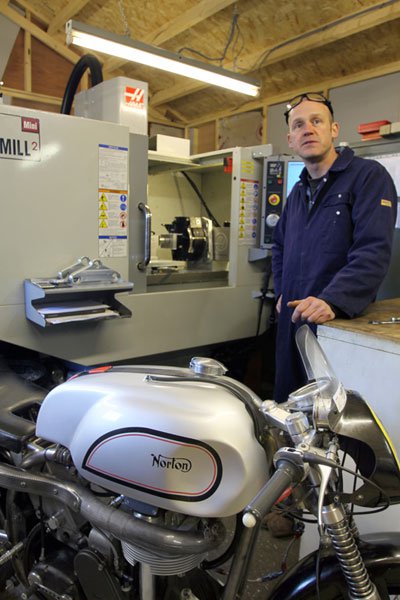Works Racing Motorcycles Ltd
Based in Stratford upon Avon, Works Racing Motorcycles Ltd is a development company focusing on high performance 4-stroke engines. Patrick Walker, company owner, says, “The Manx Norton is such a famous motorcycle that they fetch phone numbers at auction and there’s a steady market in building and racing modern replicas of the beast. I was interested in buying a CNC mill so I could machine my own engines. Using an original engine and a vernier gauge, I’d produced a 3D model of the engine using Solidworks CAD/CAM software and was ready to start getting them machined. One of the most appealing factors in getting my own CNC machine was rapid prototyping; I could machine a single casting, test it, and transfer any improvements to the next cut. This would be a very expensive process if I were using a sub-contractor.
“Whilst at Autosport 2009, I visited the Haas stand and saw the Mini Mill in operation. I had a few concerns about cutting magnesium alloy, but the Haas salesman quickly put them to rest; he’d worked for many years in the aerospace industry and had plenty of experience cutting it.
“I’d heard very good things about the standard of engineering on the Haas,” says Walker, “plus I spoke to a few other companies I know who use Haas machining centres and they gave me the thumbs-up. Of course, price was also a factor. All in all, the Mini Mill 2 was exactly what I was looking for. The fact that the Mini Mill would run on single-phase power, meaning I could have it installed in the workshop in my garden, sealed the deal.”

The Mini Mill and Haas 4th-axis rotary were delivered in March 2009 and despite having no previous experience of CNC machining, Walker managed to produced a show engine for a 1962 30M Manx Norton motorcycle, which was exhibited at the Isle of Man TT just eight weeks later.
“After getting a few ideas from Scott West, my Haas salesman, I’ve designed and built a manual 5th axis jig, which I use in conjunction with the Haas 4th axis rotary. I simply lift a lever, rotate the component and lock it in place for the next cut. By using a Stark speedy module, which is a zero point mounting system, I can change setups in seconds without having to clock the machine. It’s worth mentioning that the table on the Mini Mill is big enough for me to leave the rotary and fixturing in place permanently, which is a huge advantage.”
Walker has found programming the Haas simple and intuitive to use. “The Haas control is great, it’s really easy to use. I had a day’s training, the Haas teacher actually came here, so I didn’t have to travel, and in that short space of time I learnt enough to get cutting metal. Nowadays, whilst I’m machining parts I’m constantly thinking how I can improve on my programs, factoring in which tools will be used, making the machining process quicker and more efficient. I’m really pleased with the accuracy of the machine; the tolerances are amazing. I’m a true perfectionist these days, because I can be.
“I was testing my most recent engine on the track, the other day and the power band was through the roof. Better than the original!”
When Haas Automation unveiled the Mini Mill at MACH 2000, it quickly became one of the best selling machines in the company’s history. Its combination of small footprint, full CNC capabilities and price were unheard of in the industry. The Super Mini Mill added even more capabilities, while maintaining the same compact footprint and affordability.
Introduced to the UK in 2009, the Haas Mini Mill 2 is a versatile CNC machining centre with all the attractive features of the original Haas Mini Mill, but with extended travels of 508 x 406 x 356 mm (xyz) – roughly a 100 mm increase on each axis.
The Mini Mill 2 features a standard 40-taper spindle that spins to 6,000 rpm. It is powered by a 7.5-hp vector drive system. The 1,016 x 356 mm T-slot table provides plenty of room for multiple fixtures or a single- or dual-axis rotary table. Rapids are 15.2 m/min, with 12.7 m/min cutting feeds. Standard equipment includes a 15″ colour LCD monitor with USB port, a 10-pocket carousel-style tool changer and 1 MB of program memory. For shops needing more tools, the Mini Mill 2 has options for either a 20-pocket carousel tool changer or a 24+1 tool side-mount. Other options include 4th- and 5th-axis drives, a programmable coolant nozzle, high-speed machining software, Haas’ Intuitive Programming system, a chip auger and more.
From the start, Haas Automation has provided reliable, affordable machine tool solutions to job shops and contract manufacturers around the world, relying on volume sales rather than per-unit profit to build the company. Extensive use of lean manufacturing methods and just-in-time production practices allows the Haas Automation to produce high-precision CNC products while maintaining exacting quality and value-based pricing. USA based machine tool manufacturer Haas Automation’s business philosophy has always been to build a loyal base of customers by providing unsurpassed quality, value and service.




